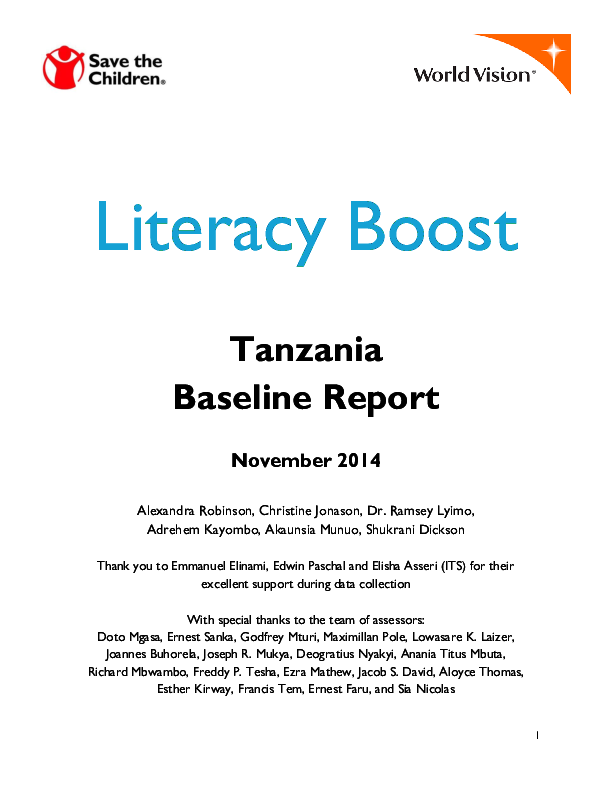
Reports
Literacy Boost Tanzania Baseline Report November 2014
Publication year:
2014
English
Format:
(1.4 MiB)
Publisher:
Save the Children,WVI, World Vision International
This report examines the results of a primary school learner background survey and reading assessment conducted in September and October of 2014. The survey and reading assessment covered 1035 Standard 2 learners from 40 schools in the Area Development Programmes of Magugu, Kisongo, Mtinko and Kinampanda Area Development Programmes (ADPs) located in Northeastern Tanzania. The 40 schools are split into 20 primary schools designated to receive Literacy Boost programming, and 20 comparison primary schools receiving no intervention this school year. Roughly 26 randomly selected students were assessed at each comparison and Literacy Boost school.
The Literacy Boost programme includes teacher training, community reading activities, and age-appropriate local language material creation to support emergent literacy skills among early-Standard children. As part of Literacy Boost, learners are periodically assessed in each of these skills through an adaptable assessment tool to inform programming and estimate programme impact. The data gathered from these schools is analyzed to present a snapshot of the emergent literacy skills of Standard 2 learners in these schools and to inform the adaptation of the Literacy Boost programme to this context.
The primary purpose of the baseline assessment is to identify the strengths and weaknesses of local learners’ reading abilities and to determine if and how skills vary by student background, home literacy environments, and school contexts. In order to ensure the reliable interpretation of programme endline results, however, the comparability of Literacy Boost (LB) and Comparison Group (CG) learners must first be examined. Significant differences in between learner groups’ skills and resources must be transparently accounted for, so that at end-line, we can know how much Literacy Boost has, or has not, contributed to learners’ accelerated reading development for in order to control for the effects any group’s comparative advantages.
The Literacy Boost Tanzania learner assessment collected data regarding children’s demographic backgrounds and home literacy environments (HLEs) and also tested children’s reading skills in both Kiswahili and English. Although Standard 2 learners primarily receive school instruction in Kiswahili, English is taught as a second language in Standard s 1 to 7, and national curriculum transitions to English-led instruction at the beginning of secondary school (Form 1). Likewise, while Literacy Boost programming prioritizes Kiswahili literacy acquisition, it is also important to prepare children for educational and language transitions. Although this report focuses primarily on children’s Kiswahili literacy skills, analysis reveals the great amount of support learners will need to begin secondary school with English language confidence. Currently, only 3.5% of all learners can be classified as English readers, while 56% of learners are Kiswahili readers.
Read full abstract
Authors
View & Download
English
1 Documents
Document information
Authors
Content type
Country
Rights
© Author/Publisher
Keywords
Found a mistake? Help us improve!
If you have noticed a document assigned to the wrong author or any other inaccuracies, let us know! Your feedback helps us keep our data accurate and useful for everyone.
Share
Link
